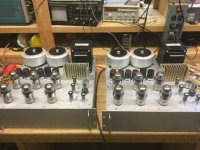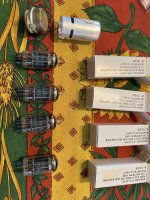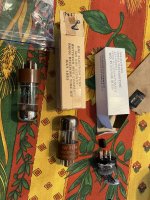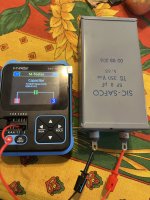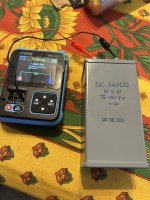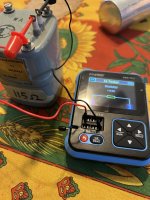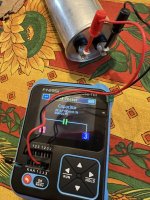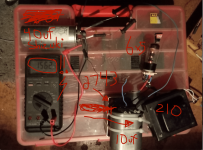Thank you @anatech for all your feedback...
I will try to read about line-stage with/without feedback. My understanding is the original Japanese circuit had two 5687 tubes, but it is possible to simplify the circuit to use the two halves of the same tube.
I assume this still means the original circuit was as you called it open loop or without feedback? Not trying to significantly change the original circuit as it - from what I understand - was an award winning circuit back in the day. Has anyone seen amps based on it? Is the open loop an issue in SQ?
A line stage with feedback would be a more significant change?? I need to get past page 3 of the book 🤣 😎 This is a damn tough hobby to get into.
I will try to read about line-stage with/without feedback. My understanding is the original Japanese circuit had two 5687 tubes, but it is possible to simplify the circuit to use the two halves of the same tube.
I assume this still means the original circuit was as you called it open loop or without feedback? Not trying to significantly change the original circuit as it - from what I understand - was an award winning circuit back in the day. Has anyone seen amps based on it? Is the open loop an issue in SQ?
A line stage with feedback would be a more significant change?? I need to get past page 3 of the book 🤣 😎 This is a damn tough hobby to get into.
Well, winning awards has little to do with performance sometimes.
Searching for "the best" using people's opinions is hazardous at best. I won't go there. Go ahead and try it and see. Keep an open mind and try some other things.
One great way to learn is by using good, older equipment that has been checked out and found to be operating properly. On average, equipment from 1980 plus or minus is the best that was produced. A few manufacturers make even better stuff, but that depends on make and model. Consumer reports? Useless. Reviews, even more useless.
Ignore what you are told or read in audio press. Just simply use the stuff on decent speakers. See what you think. I find the most honest opinions come from children and women not interested in audio. I use and design both tube and solid state electronics.
Searching for "the best" using people's opinions is hazardous at best. I won't go there. Go ahead and try it and see. Keep an open mind and try some other things.
One great way to learn is by using good, older equipment that has been checked out and found to be operating properly. On average, equipment from 1980 plus or minus is the best that was produced. A few manufacturers make even better stuff, but that depends on make and model. Consumer reports? Useless. Reviews, even more useless.
Ignore what you are told or read in audio press. Just simply use the stuff on decent speakers. See what you think. I find the most honest opinions come from children and women not interested in audio. I use and design both tube and solid state electronics.
Cool. We are talking a circuit from 1993. So we’re less than a teenager away from that.On average, equipment from 1980 plus or minus is the best that was produced.
I remember my first Phillips top load non motorized CD Player I bought in 1980. Changed my world.
I just built a DAC that made my music like I am hearing CDs for the first time again which is so cool. So I kind of got the audio bug again like I was 18 again.
And I am hoping combining my new digital world with a tube pre will even make another good difference others have told me about.
Hi all,
Re the modified linestage circuit, I had Lundahl LL1565 specified as input transformers as you can see in the diagram that someone recommended. They are XLR to SE "dongle" type converter but he suggested "internal" ones that can go inside the linestage. I went to order some from Lundahl directly and they recommend the LL1545E which have - it looks like - improved shielding and made to go inside.
I have asked them for wiring instructions for my application. Assuming it will be XLR input jacks to mount on my case connected to the proper primary windings and secondary connections to my line stage input circuit.
I admin I have an XLR fetish 😎 . Step one. Also my analogue output board on the DAC does have SE and XLR outputs, but it is recommended by the board manufacturer to only use the SE for testing, and XLR for listening - which I do today sans pre-amp.
https://www.lundahltransformers.com/wp-content/uploads/datasheets/1545e.pdf
Maybe this can help someone else looking for an input transformer....
Re the modified linestage circuit, I had Lundahl LL1565 specified as input transformers as you can see in the diagram that someone recommended. They are XLR to SE "dongle" type converter but he suggested "internal" ones that can go inside the linestage. I went to order some from Lundahl directly and they recommend the LL1545E which have - it looks like - improved shielding and made to go inside.
I have asked them for wiring instructions for my application. Assuming it will be XLR input jacks to mount on my case connected to the proper primary windings and secondary connections to my line stage input circuit.
I admin I have an XLR fetish 😎 . Step one. Also my analogue output board on the DAC does have SE and XLR outputs, but it is recommended by the board manufacturer to only use the SE for testing, and XLR for listening - which I do today sans pre-amp.
https://www.lundahltransformers.com/wp-content/uploads/datasheets/1545e.pdf
Maybe this can help someone else looking for an input transformer....
Yes, they make good transformers.
Guess what? An engineer revamped the Hammond line of audio transformers. Well worth listening to.
Too bad they are domestic. No one will give them a break, but they are very good.
About CD players. How the audio is treated makes a massive difference. I improve many stages, some can't be helped. So you can have exactly the same DAC chip, but the digital filter, PCB layout and filter and output circuits make all the difference in the world. That's why CD players can sound different, but the sub $1K units normally sound terrible.
When going balanced, it isn't universally better than single ended. It depends on distance and other factors. Under normal conditions an RCA or single ended connection is actually the best. Even your guitar pickups are single ended, and those are mic level signals. You could run them as balanced, but the extra expense shouldn't buy you anything. With audio, the devices used to go from balanced to single ended can be a source of distortion. If active, a source of noise at those levels. A normal CD player has a sub-10 ohm output impedance normally speaking. They may have a series resistor. That's a far cry from the normal 2K plus impedance from a tube stage, unbuffered. Under those conditions, you are way further ahead with single ended. If the tube stage is transformer coupled you end up with high signal levels on the tube side (= higher distortion). It's all a trade-off.
Guess what? An engineer revamped the Hammond line of audio transformers. Well worth listening to.
Too bad they are domestic. No one will give them a break, but they are very good.
About CD players. How the audio is treated makes a massive difference. I improve many stages, some can't be helped. So you can have exactly the same DAC chip, but the digital filter, PCB layout and filter and output circuits make all the difference in the world. That's why CD players can sound different, but the sub $1K units normally sound terrible.
When going balanced, it isn't universally better than single ended. It depends on distance and other factors. Under normal conditions an RCA or single ended connection is actually the best. Even your guitar pickups are single ended, and those are mic level signals. You could run them as balanced, but the extra expense shouldn't buy you anything. With audio, the devices used to go from balanced to single ended can be a source of distortion. If active, a source of noise at those levels. A normal CD player has a sub-10 ohm output impedance normally speaking. They may have a series resistor. That's a far cry from the normal 2K plus impedance from a tube stage, unbuffered. Under those conditions, you are way further ahead with single ended. If the tube stage is transformer coupled you end up with high signal levels on the tube side (= higher distortion). It's all a trade-off.
Nope, it's an old circuit refried in 1993 or thereabouts. Whatever is old is new again. You will probably find something really close in an old piece of tube audio equipment.Cool. We are talking a circuit from 1993. So we’re less than a teenager away from that.
XLR fetish? That’s what happens when you get tired of fighting ground loops and build the whole damn system balanced interconnect.
Those little $65-ish Hammond transformers are nice. Absolutely transparent to me. But I did put XLRs on the back of it, considering where these typically get used. Note the little mu metal cans.
Those little $65-ish Hammond transformers are nice. Absolutely transparent to me. But I did put XLRs on the back of it, considering where these typically get used. Note the little mu metal cans.
Attachments
lol!
I don't have ground loops!
I once put an entire two story jingle studio on single ended to solve level and noise problems. They had a mix of pro and semi-pro gear. Once I was done, no hum and 0 Vu was 0 Vu everywhere.
Normally you're right in a multi-equipment recording studio or similar. But for a home stereo, someone had to goof to cause a ground loop. This just isn't normal. Fix the goof, not the cabling. It often turned out to be a piece of "high end", small production gear that caused the problem.
I don't have ground loops!
I once put an entire two story jingle studio on single ended to solve level and noise problems. They had a mix of pro and semi-pro gear. Once I was done, no hum and 0 Vu was 0 Vu everywhere.
Normally you're right in a multi-equipment recording studio or similar. But for a home stereo, someone had to goof to cause a ground loop. This just isn't normal. Fix the goof, not the cabling. It often turned out to be a piece of "high end", small production gear that caused the problem.
That sort of stuff is half-*** designed about half the time.
“The goof” in this case is the grounded source equipment and the grounded amp rack being plugged into separate buildings, or separate breakers in the same one. You just can not carry the signal return on the ground so I don‘t bother trying anymore. Transformer, XLR, or both. No exceptions.
“The goof” in this case is the grounded source equipment and the grounded amp rack being plugged into separate buildings, or separate breakers in the same one. You just can not carry the signal return on the ground so I don‘t bother trying anymore. Transformer, XLR, or both. No exceptions.
Okay, that's a no-brainer! Of course you have ground currents!
Yes, transformer couple the audio. It doesn't have to be balanced, but given the distance it's a great idea. I run into this situation in paging systems on large campuses.
Anyway, in a home system there is no reason for ground loops. For what you described - sure. Not for what we are talking about though. I could have brought up the industrial systems I do, but that situation doesn't apply here.
Yes, transformer couple the audio. It doesn't have to be balanced, but given the distance it's a great idea. I run into this situation in paging systems on large campuses.
Anyway, in a home system there is no reason for ground loops. For what you described - sure. Not for what we are talking about though. I could have brought up the industrial systems I do, but that situation doesn't apply here.
The idea is those little 10k:10k Hammonds will solve the worst problems anyone is likely to run into, dont really break the bank, and do nothing to hurt the sound.
I was actually a little more surprised how well the little $6 Triads did. As long as it’s being driven by a low Z source (even a run of the mill CD player).
I was actually a little more surprised how well the little $6 Triads did. As long as it’s being driven by a low Z source (even a run of the mill CD player).
Hi wg_ski,
Absolutely! Properly used, isolation transformers can work miracles.
I'm not familiar with the Triad parts. In industrial applications I have to specify packaged solutions (Bogen or whoever), for a part, the client normally specifies the part 'cause they read up on it. Otherwise I'll use a Hammond. Performance is excellent and easier for me to get.
Absolutely! Properly used, isolation transformers can work miracles.
I'm not familiar with the Triad parts. In industrial applications I have to specify packaged solutions (Bogen or whoever), for a part, the client normally specifies the part 'cause they read up on it. Otherwise I'll use a Hammond. Performance is excellent and easier for me to get.
Hammond anything is just a Mouser order away. Half or less than Jensen.
One of the other tube guys turned me on to those open frame Triads that are rated to only 200 Hz. Ive yet to find a hi-fi-ish PA duty that they’re not suitable for. You’ll get 40 easy out of them driven by an op amp and it’s usual 150 ohm output protection resistor. When building tube preamps I use video pentodes strapped as followers. I used to use EL84’s. Wont quite drive a welding rod, but 200 ft STP or the lowish inductance of one of those transformers no problem. Yeah, the Hammonds are better, but I don’t always need better and at six bucks….
One of the other tube guys turned me on to those open frame Triads that are rated to only 200 Hz. Ive yet to find a hi-fi-ish PA duty that they’re not suitable for. You’ll get 40 easy out of them driven by an op amp and it’s usual 150 ohm output protection resistor. When building tube preamps I use video pentodes strapped as followers. I used to use EL84’s. Wont quite drive a welding rod, but 200 ft STP or the lowish inductance of one of those transformers no problem. Yeah, the Hammonds are better, but I don’t always need better and at six bucks….
Hammond transformers for 65$ - please exactly which models are You talking about ?
( Last time i had a look at Hammond it was 1140 series which are around 100 Eu per piece ).
( Last time i had a look at Hammond it was 1140 series which are around 100 Eu per piece ).
Different pricing... different parts of the world... plus... quantity discounts... Ensure you're on the US website. $66.72 for 50 or more, and that was the very first link I found. Perhaps cheaper direct from Hammond or from other distributors.
https://www.mouser.com/ProductDetail/Hammond-Manufacturing/1140-LN-B?qs=u4fy/sgLU9N8oZ9ce5x0Eg==
https://www.mouser.com/ProductDetail/Hammond-Manufacturing/1140-LN-B?qs=u4fy/sgLU9N8oZ9ce5x0Eg==
Thanks, it is the same series i looked previously, just some other impendances ( 600 : 600 and 1K : 1K ).
I am looking in UK and 1140-LN-B is there 67,47 GBP + VAT.
I am looking in UK and 1140-LN-B is there 67,47 GBP + VAT.
Hi wg_ski,
For your application the Triads are perfect. I'm thinking of packaging them in equipment for PA applications and you really don't want much around 200 Hz anyway, 400 Hz gives horns a headache! They may be perfect.
The last Hammonds I used was before COVID, and prices have gone nuts everywhere. I was looking at $35 ~ $40 each at the time (input coupling). These are for high fidelity, not PA apps. So those customers are used to paying huge amounts for transformers.
I had Hammond design some output transformers for me, 40 W ultralinear. They did a fantastic job! Expensive, but they made all the difference in my amp design. The best part is that they are about 1/2 an hour away from me. 🙂
For your application the Triads are perfect. I'm thinking of packaging them in equipment for PA applications and you really don't want much around 200 Hz anyway, 400 Hz gives horns a headache! They may be perfect.
The last Hammonds I used was before COVID, and prices have gone nuts everywhere. I was looking at $35 ~ $40 each at the time (input coupling). These are for high fidelity, not PA apps. So those customers are used to paying huge amounts for transformers.
I had Hammond design some output transformers for me, 40 W ultralinear. They did a fantastic job! Expensive, but they made all the difference in my amp design. The best part is that they are about 1/2 an hour away from me. 🙂
Hey all. Offline for a couple days. I have parts arriving soon for the power and signal stage. I’ll get some pictures up as soon as I can so we can get back to the “Serious Pre” circuit.
Reading some of those links sent to me in meantime.
Reading some of those links sent to me in meantime.
Update and Pictures.
I received a lot of my parts Friday. Some damage in shipping. One 6x5 broke but I have a spare and the Shizuki 40uf Cap got smushed a bit. I bought a similar cap in the meantime until I find a replacement. Canada Post for ya! Last shot of the parts working before shipped to me.

I received a lot of my parts Friday. Some damage in shipping. One 6x5 broke but I have a spare and the Shizuki 40uf Cap got smushed a bit. I bought a similar cap in the meantime until I find a replacement. Canada Post for ya! Last shot of the parts working before shipped to me.
Attachments
Last edited:
Re the output transformers, I decided on the Tango's. They will ship next week.
Here are updated 3D models based on actual measurements of parts. I don't have the input transformers, jacks, wiring modelled yet.
But I will make test top plates with holes out of wood first to check mounting of parts. The enclosure is 9"x18"x80mm (inside height). I could maybe make it 16" vs 18". We'll see.
Will update my circuit diagram tomorrow.

Here are updated 3D models based on actual measurements of parts. I don't have the input transformers, jacks, wiring modelled yet.
But I will make test top plates with holes out of wood first to check mounting of parts. The enclosure is 9"x18"x80mm (inside height). I could maybe make it 16" vs 18". We'll see.
Will update my circuit diagram tomorrow.
Attachments
Clever 👍But I will make test top plates with holes out of wood first to check mounting of parts.
- Home
- Amplifiers
- Tubes / Valves
- "Serious Pre" Tube Build
